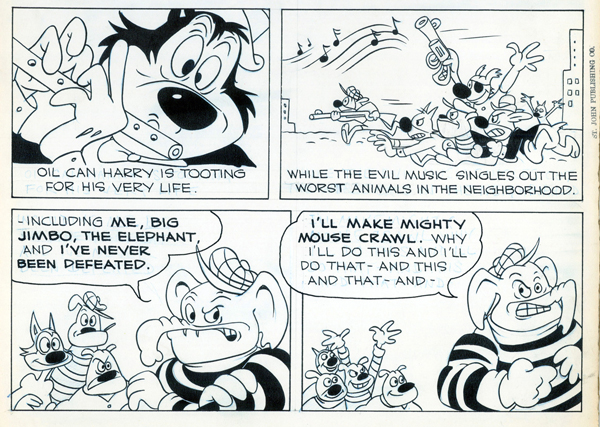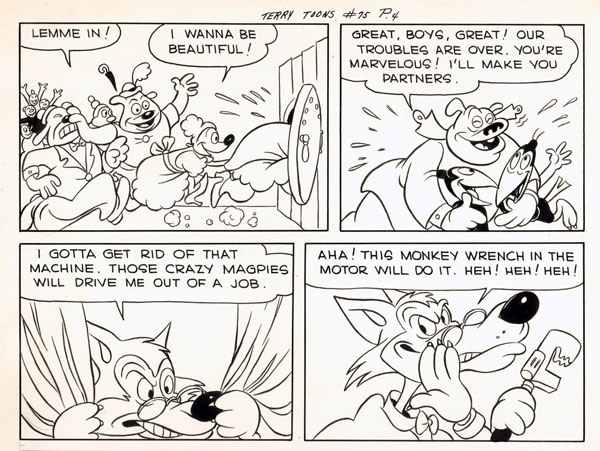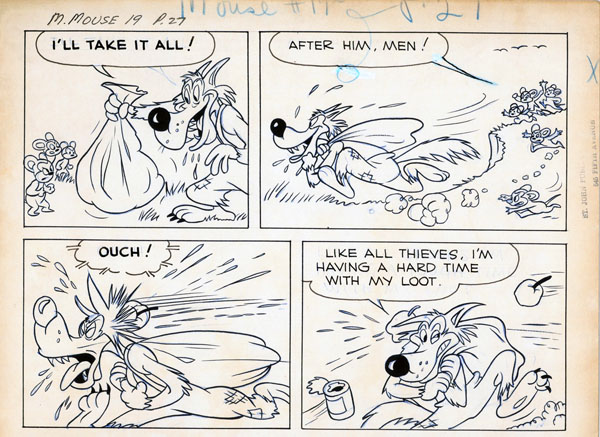
“Temper Temper”—Little Roquefort #7 (June 1953). Panel inked by “Renza”. Note how much this inker redraws/“fixes”the character.
ANIMATORS IN FUNNY ANIMAL COMICS
Jim Tyer, part 2: Terrytoons Characters and 1960s Felix Stories
While many animated cartoon characters were mostly licensed and published by Dell Comics, the stable of characters from Paul Terry’s studio appeared in magazines created by Timely Comics, with the first issue of Terry-Toons Comics published in October 1942. Terry’s characters Dinky Duck and Gandy Goose, paired with Sourpuss the cat, appeared in the early issues. Other characters were Timely staff creation that only existed in the comics, including Frenchy Rabbit, Oscar Pig, Wacky Willy and Andy Wolf.AUTHOR’S NOTE: As an addendum to my previous column, Tyer-Part 1, Milton Knight reminded me that Tyer drew at least one story for Consolidated Magazine’s Key Comics, in issue #5 (August 1946) — “Tommy’s Time Key.” Moreover, the gnome character that bestows Tommy the key to travel through time slightly resembles “Nicky Nome”, a character from several animated industrial films from Jam Handy’s Detroit studio, where Tyer animated during the late ‘30s.
During this same month, Terry’s studio released The Mouse of Tomorrow, which featured their new character “Super Mouse”, parodying the immense popularity of Superman. And that month, Nedor Publishing issued their first Coo-Coo Comics magazine, featuring a super rodent, also named Super Mouse. To avoid nomenclature confusion, Terry’s super mouse was changed to Mighty Mouse after his first seven cartoons. Mighty Mouse appeared in Terry-Toons Comics by November 1945, and headlined his own series, published in the fall of 1946, both published by Timely.
The license for Terrytoons characters was taken over by St. John Publishing—located on 545 Fifth Avenue in Manhattan—by September 1947, with Terry-Toons Comics, issue #60. With the St. John Terrytoons comics, several of the animators working at Paul Terry’s studio drew the stories, including animator/director Connie Rasinski and background artist Art Bartsch, who often signed their work. Others included animators Carlo Vinci, Reuben Timmins, and Jim Tyer.
By 1947, Tyer had been fired from Famous Studios and no longer drew stories for Nedor Publishing’s line of comics. He re-located to New Rochelle to work for Terry, and began drawing stories for the St. John comics by October 1948. Unlike the other animators freelancing for Terry’s licensed comics, handling more conventional narratives, Tyer wrote his own stories, which often led to strange but humorous ideas.He drew stories for Mighty Mouse, Heckle and Jeckle, Little Roquefort and the Terry Bears. Strangely, it seems that Tyer didn’t draw any stories with Gandy Goose and Sourpuss for St. John.
Unlike the Nedor comics, Tyer didn’t ink many of his stories for St. John; surviving artwork from the comic pages revealed the multiple inkers responsible on the reverse side. Frank “Sparky” Schudde, later a production manager for Terry’s studio in the late ‘50s, inked entire stories for Tyer, while some inkers handled different pages for one story. Art Bartsch inked on some of Tyer’s stories, but many of the others are difficult to identify, despite their signatures (sourced from collectors who have obtained the original artwork)—“R. Santi”, “Renza”, “Muriel”, “Craig”, “Trina” and “Bushnell” are among them.
 By 1956, St. John Publications folded and CBS bought Terry’s studio from him, leading to his retirement, with Gene Deitch as his successor. Tyer drew (and assumedly, inked) his stories for the new characters in Terry’s roster—Tom Terrific, Clint Clobber, Gaston le Crayon and Flebus. The licensing had been taken over by Pines Comics, a re-naming of the Nedor comics line-up run by Ned L. Pines. Tyer was able to adapt to the new drawing style brought along under Deitch’s regime in the theatrical cartoons, and his comic book work, as well. Dell Comics took over the licensing in 1959, but Tyer’s work isn’t seen in these stories—presumably due to his departure from Paul Terry’s studio that same year.
By 1956, St. John Publications folded and CBS bought Terry’s studio from him, leading to his retirement, with Gene Deitch as his successor. Tyer drew (and assumedly, inked) his stories for the new characters in Terry’s roster—Tom Terrific, Clint Clobber, Gaston le Crayon and Flebus. The licensing had been taken over by Pines Comics, a re-naming of the Nedor comics line-up run by Ned L. Pines. Tyer was able to adapt to the new drawing style brought along under Deitch’s regime in the theatrical cartoons, and his comic book work, as well. Dell Comics took over the licensing in 1959, but Tyer’s work isn’t seen in these stories—presumably due to his departure from Paul Terry’s studio that same year.
As more television animation was being produced, Tyer moved on to work for the studios of Joe Oriolo (Felix the Cat) and Hal Seeger (Milton the Monster and Batfink), and also worked at Paramount on their King Features Syndicate adaptations of comic strip characters such as Snuffy Smith. Around 1963, Dell Comics issued a second iteration of Felix comics, where Tyer drew many of the stories—and the front covers— for issues #2 through #8, with Felix, and some featuring Rock and Rollo. (It seems he drew the entirety of issue #4, as well.) To my knowledge, Tyer didn’t draw any comic book stories after these Felix issues.

“Twin Destroyers” (Unknown issue, 1956). Page inked by “Trina”.
Now, here’s a random selection of Jim Tyer’s stories featuring various Terrytoons characters, as well as a small number of Felix stories from the early 1960s. There was a large amount to choose from, in the case of the Terry comics, so I apologize if there is a story I haven’t included on the list. Hope you all enjoy reading them…just don’t get “Tyer”-ed out!
• “Who is Mighty Mouse?” — Mighty Mouse #10 (April 1949): One of Tyer’s earliest stories with Mighty Mouse, portraying a tale of one of Mighty’s ancestors in the Middle Ages.
• “The Phony Crime” (Heckle & Jeckle)—Blue Ribbon Comics #3 (June 1949): How bored could one be to have the notion of fooling a police department by faking a murder scene? Only Heckle and Jeckle.
• “The Misdirected Scarecrow” (Heckle & Jeckle)—Terry-Toons Comics #74 (June 1949): As with many of Tyer’s stories with the scheming magpies, they invent a new “get rich quick” device—in this case, a remote-controlled scarecrow to be used for interior decorating.
• “Rudy’s Rude Awakening” (Dinky Duck)—Blue Ribbon Comics #6 (August 1949): Rudy Rooster uses a magic paint to observe his surrounded with rose-colored glasses, but his reality comes back to haunt him. What a harsh comment on Rudy’s report card on page 4, too.
• “The Perils of Pearl Pureheart” (Mighty Mouse)—Mighty Mouse #15 (February 1950): One of the many “Pearl Pureheart” melodramas by Tyer, with Oil Can Harry planning to destroy the entire town with a massive amount of explosives. Further evidence of Tyer writing his own stories for the Terrytoons characters is seen in an unused ending, in his handwriting, written on the back of page 6.
• “It Happened in Rhode Island” (Mighty Mouse)—Mighty Mouse #23 (February 1951): A strong alien race invades the Earth, planning on taking each of the United States back to their home planet, one by one.
• “The Perils of Pearl Pureheart” (Mighty Mouse)—Mighty Mouse #26 (May 1951): Set in the Stone Age, Oil Can Harry hypnotizes a dinosaur to help him destroy Mighty Mouse. Wonderful drawings of the dinosaur here.

“Perils of Pearl Pureheart”—Mighty Mouse #25 (April 1951). Page inked by “Muriel”.
• “The Joking Jackass” (Dinky Duck)—Dinky Duck #2 (January 1952): Dinky and Rudy study the power of jujitsu to battle against a bullying donkey in the schoolyard.
• “The Perils of Pearl Pureheart” (Mighty Mouse)—Mighty Mouse #32 (May 1952): In another story involving remote-controlled beings, Oil Can Harry uses an army of suited knight’s armor to enslave the mice to work in a salt mine. There are some deranged-looking eyes on Oil Can Harry throughout much of this tale—it’s marvelous.
• “Davey Jones’ Locker” (Heckle & Jeckle)—Paul Terry’s Comics #100 (April 1953): H&J search for buried treasure underwater, but come across a gun-wielding lobster and his partners.
• “Papa’s New Eyeglasses” (Terry Bears)—Paul Terry’s Comics #102 (June 1953): Papa Bear is long overdue for a pair of prescription glasses, but his surroundings turn out more odd than before.
• “Temper, Temper” (Little Roquefort)—Little Roquefort #7 (June 1953): Percy the cat “burns up” after each time Little Roquefort outsmarts him, until the effects of his temper overtake him.
• “The Singing Teacher” (Terry Bears)—Mighty Mouse #45 (October 1953): Papa Bear hires a vocal teacher so his two sons can become cultured gentlemen, but his plans backfire upon her arrival. The last two panels of the story provide a nice ending, too.
• “Strange Footprints” (Flebus)—Mighty Mouse Fun Club Magazine #1 (Fall 1957): This unique tale about the mind’s alternative capabilities inspired a Paramount cartoon a decade later, Think or Sink (1967)—directed by Shamus Culhane, with Tyer credited on the story.
• “Ancient China” (Tom Terrific)—Mighty Mouse Fun Club Magazine #2 (Winter 1957): Crabby Appleton uses logs to obstruct the resourceful Tom Terrific and Mighty Manfred’s exit from China.
• “The Big Surprise” (Clint Clobber)—Mighty Mouse Fun Club Magazine #4 (Summer 1958): Feeling his tenants of the Flamboyant Arms are renouncing him, Clint Clobber decides to use his authority against them.
• “A Dreamy Diet!” (Clint Clobber)—Mighty Mouse Fun Club Magazine #6 (Winter 1958): In this strange comic story, Clint starts to float around in the Flamboyant Arms, much to the shock of his tenants.
• “Beaux and Arrows”—Felix the Cat #2 (January-March 1963): Felix and his rival Pussyfoot fight for Kitty’s affections at the county fair.
• “Fair Weather Enemies”—Felix the Cat #3 (April-June 1963): Felix and Pussyfoot both have dates with Kitty on the same day. A compromise is made depending on the weather outside—if it’s sunny, she’ll picnic with Pussyfoot, but if it rains, she’ll go to the movies with Felix. Who shall it be?
• “Too Much Energy” (Rock & Rollo)—Felix the Cat #8 (July-September 1964): This could be one of the final comic book stories drawn by Tyer. In this story, Rollo uses a “magic work spray” on the lazy Rock, but the dosage is too strong—Rock is now all too obsessed with assisting his friend on housework.
(Thanks to Mark Newgarden, Milton Knight and Mark Kausler for their help.)

Tyer originals in this post provided by Mark Newgarden

“The Mad Puppet”—Terry-Toons Comics #80 (June 1950). Story inked by Frank “Sparky” Schudde.

“The Runaway Freight Train”—Mighty Mouse #19 (October 1950). Story inked by Frank “Sparky” Schudde.




 DEVON BAXTER is a film restoration artist, video editor, and animation researcher/writer currently residing in Pennsylvania. He also hosts a
DEVON BAXTER is a film restoration artist, video editor, and animation researcher/writer currently residing in Pennsylvania. He also hosts a 




















































































As whacked out as the plots of some of these entries were, there’s a certain intelligence to them that would escape most kids today (a reference to the Battle of Hastings, indeed, plus all the faux-Elizabethan English). Tyer was nothing if not literate, and his drawing style was unique, if a bit insane. The man was a genius.
Thanks for this terrific post (and pt. 1 too )!! I love Tyers work in the cartoons and the comics- what a sensational animatior/artist. I especially appreciate the comics and original comic page art you’ve included. Keep up the good work as I always look forward to Wednesdays on this here Research blog. DJA
Three of those comic inkers you named would be Ronny Santi, Connie Renza and Muriel Gushue. Santi was an inbetweener at Terrytoons in the mid 40s, not sure if he ever became an animator. Gushue was an ink and paint woman. I wonder if “Craig” could be the great Fleischer and Terrytoons BG painter Anderson Craig?
Hi Devon,
Speaking of Gandy and Sourpuss, do you know who drew their stories during the St. John/Pines era? My candidate is Bob Kuwahara, the style of Gandy and Sourpuss looks a lot like his “Marvelous Mike” daily strip of the early 1950s. Thanks for this great post, with all the original art! As I wrote you, I have the original art for a Tyer Gandy and Sourpuss one-pager for Pines Comics.
Mark
Mark:
It seems Kuwahara was the regular artist for the Gandy and Sourpuss stories. I’ve seen a few stories that were also drawn by Connie Rasinski and Carlo Vinci.
Tyer was a big influence on the Bakshi animators on the 1987 Mighty Mouse show. A model sheet clearly read “Tyer expreessions–use with caution!”
I wonder what episodes used the “Tyler Expressions”.
Those Felix comics are pretty great!
Loving these Tyer comics! I have a 1956 Pines Mighty Mouse comic (Adventures of Mighty Mouse #129), and I’m not sure if it has Tyer art. The Terry Bears one-pager in the inside-front cover looks like his art, and the Dinky story in that issue has a bizarre plot that scream Tyer. Could you confirm?
Do you know if Tyer drew Little Roquefort comics? I own the cover to # 2 and it is unsigned.
Frank Schudde was my grandfather, he was the production manager for Terrytoons, he worked on every episode of The Deputy Dawg Show, 104 episode in all.. He was just an animator when he started. he was contacted by Hanna Barbera located in California, but he loved New York and so did my grandmother at the time she was not leaving Brooklyn. His wife passed away when my father was 12 and his older brother was 16. grandpa used to take cells home and my grandmother would color them in. That’s how he became production manager. anyway after his wife died he started drinking alot and got in a huge fight with Bob Weiss and was fired. He then opened a malt shop/ ice cream/ candy store. It was a front because he was a bookie at the time. My grandfather had a very interesting life, unfortunately my grandmother passed away when my dad (also named Frank Schudde) was young so he didn’t really talked to him to find out more about his life… Grandpa did love drawing but animators worked ungodly hours and almost always recieved no credit for their work. I didn’t even know he inked a whole series of comics for Tyer. Luckily there’s kind of an interest in older cartoons and comics. His nickname that I knew was minor because he was the youngest of 5 brothers. Younger by a lot. We are catholic so when his mom got pregnant with my grandfather it was considered a high risk pregnancy and she died giving birth to him. If anyone knows why he was called Sparky please email me at robinmarie103@gmail.com. All my research has not come to anything again his nickname was always minor to his family. it seems “Sparky” was a nickname at work.